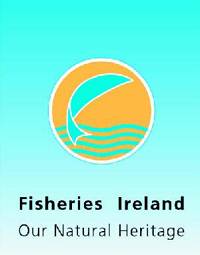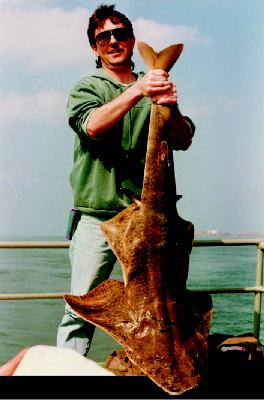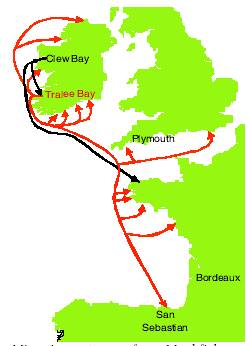| 2002 |

|
YEAR BOOK |
CENTRAL FISHERIES BOARD
|
Monkfish migrations
|

In 1970 the Inland Fisheries Trust (now the Central Fisheries Board) initiated a tagging programme for marine sport fish. Virtually no information existed on the migration or mobility of these species and tagging was seen as a way of gathering valuable information on their movements. The tagging programme was introduced as a conservation measure, which would ensure that fish captured were returned tagged and alive to the water rather than being killed. Sea angling tourism revenue is worth over �30 million to the Irish economy.
The tagging operation was carried out on a voluntary basis. Skippers of angling charter vessels agreed to tag the targeted species and record data on the fish in a dedicated tagging log book. Accurate details, such as the tag number, location of tagging, date of tagging, length, weight and sex of the fish, were all recorded where possible so that details of migratory patterns could be worked out from subsequent recaptures.
Monkfish or Angel fish (Squatina squatina)was one of the species selected for tagging. The two prime locations for capturing numbers of these species were Tralee Bay and Clew Bay. Initially, two types of tags were tried out � Jumbo Rototags (which are used on the ears of cattle), and Petersen discs. The voluntary taggers found that, when the monkfish were taken on board for tagging, they could be quite aggressive, and great care had to be taken when they were being handled. For this reason they opted for the Jumbo Rototag which was much easier to use when inserting the tag into the dorsal fin using an applicator.

Tag returns
The general areas of recapture are shown in the map and to-date 187 recaptures have been recorded (18.3%), which is a high return rate for any tagged fish. The main bulk of recaptures have been taken by rod and line angling (47.6%), trawling (19.25%), tangle nets (16%) and gill nets accounted for 5%. Five tags have been found washed ashore on beaches and it is possible that these tags could have been ripped from the fish during netting operations. All the fish recaptured by anglers on rod and line were subsequently returned to the water alive.

The longest number of days a monkfish was at liberty was 4,525 days (over 12 years). This fish, which was originally tagged in Tralee Bay, was recaptured 3 km north of Kerry Head after 4,498 days, released again and, after a further 27 days, was recaptured again off Bunmahon, Co. Waterford � some 345 km away. At least three further fish were at liberty for over ten years. These three fish were originally tagged in Tralee Bay and were recaptured within the general Tralee Bay area where they were originally tagged. The longest distance travelled by a recaptured monk-fish was 1,160 km. This fish was tagged in Tralee Bay and recaptured by a trawler off San Sebastian, Spain, in the Bay of Biscay.
96 recaptures have been recorded from the Tralee Bay area. This reflects the intensity of fishing effort by both anglers and commercial fishing. Commercial fishing effort is not specifically targeted at the species. Having analysed the angling fishing effort in Tralee Bay from 1977 onwards, there is a dramatic fall off in the numbers of monkfish being caught recently. In the five year period 1987�1991, 320 fish were tagged whereas, in the period 1997�2001, only 16 fish have been tagged despite the angling effort being relatively constant.
Contact: Dr Paddy Fitzmaurice,
Director of Research, Central Fisheries Board,
Mobhi Boreen, Glasnevin, Dublin 9; San Sebastian
Tel: 01-8842600; Fax: 01-8360060;
E-mail: [email protected]
Web: http://www.cfb.ie